By the VCCC project team
Part 1: Good-practice and sustainable models for Cultural Strategy development: Approaches and experiences from Fenland, Derbyshire, and Kent
Informing the development of Leicestershire County Council’s (LCC) Cultural Strategy
 A selection of on-screen delegates in attendance at the Symposium
A selection of on-screen delegates in attendance at the Symposium
On the morning of Tuesday 25th April 2023, we hosted a virtual Cultural Strategy Symposium that brought together regional and national stakeholders from policymaking, business, industry, and Voluntary, Community, and Social Enterprise (VCSE) sectors to share learning relating to three main areas. First, to exchange knowledge on and around good-practice and strategic models underpinning effective delivery of creative and culture-based work in different geographical regions and places in England. Second, to gain insight into the deployment of cultural and heritage assets to improve productivity. Third, to learn about innovative strategies for marshalling diverse talent pools into drivers of the creative and visitor economies which, in turn, are contributing towards repositioning local and regional economies as equitable and inclusive environments.
The understanding is that positive developments in these three areas significantly benefit places and regions, and the people who live and work in them. The same applies to people who visit them. As stewards of places and regions, local authorities are best placed to shape those positive developments for the benefit of diverse publics and local communities — often through crafting place-based cultural strategies.
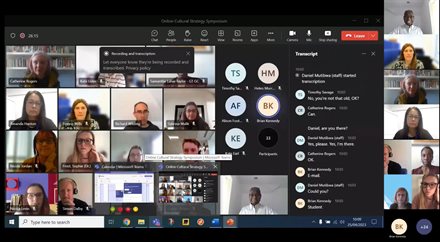 A further selection of on-screen delegates in attendance at the Symposium
A further selection of on-screen delegates in attendance at the Symposium
It is this context that set the stage for the Symposium. The University of Nottingham (UoN) has partnered with Culture Leicestershire (CuL) at LCC to co-produce an inclusive Cultural Strategy in close collaboration with wide-ranging stakeholders across the county. The overarching goal is to collaboratively co-design a Cultural Strategy for LCC that strategically guides the alignment of culture, heritage, and creative industries work across Leicestershire. CuL has a strong interest in:
- enabling cultural provision across Leicestershire to thrive;
- connecting to other cultural providers to explore possibilities for meaningful collaboration and synergies to achieve greater impact;
- developing cultural provision to be more inclusive; and
- facilitating much broader engagement with cultural activity for much wider benefit.
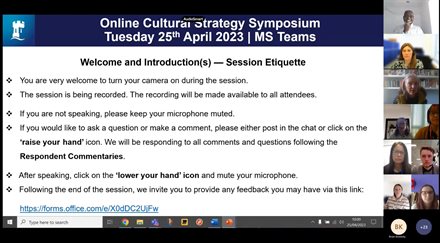 Welcome and introductory messages delivered by the VCCC project team
Welcome and introductory messages delivered by the VCCC project team
Following a scoping exercise that mapped demonstrably good-practice and sustainable models for Cultural Strategy development nationally and internationally, we invited three policy officers from three different local authority organisations as keynote speakers to share approaches, experiences, and learning that would shape development of an LCC Cultural Strategy going forward. The keynote speakers were:
- Jaime-Lea Taylor (Creativity and Culture Development Officer, Fenland District Council);
- Alison Foote (Senior Economic Development Officer, Culture, Heritage and Tourism, Derbyshire County Council), and
- Lucy Keeley (Principal Project Officer, Cultural and Creative Economy Service, Kent County Council).
Jaime-Lea, Alison, and Lucy spoke in that order.
Part 2: Cultural Strategy development: The approach and experience from Fenland
The importance of understanding the ‘DNA’ of places before Cultural Strategy development commences
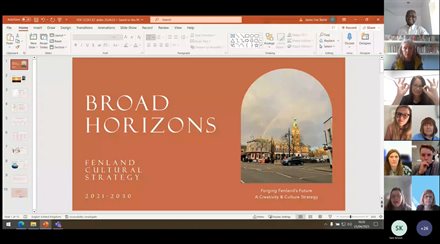 Jaime-Lea Taylor introducing the process that Fenland District Council underwent when developing Broad Horizons. Broad Horizons is the first Cultural Strategy for Fenland District in Cambridgeshire
Jaime-Lea Taylor introducing the process that Fenland District Council underwent when developing Broad Horizons. Broad Horizons is the first Cultural Strategy for Fenland District in Cambridgeshire
Jaime-Lea kick-started the keynote presentations by introducing the process of developing Fenland District Council’s (FDC) Cultural Strategy which is entitled Broad Horizons: Forging Fenland’s Future. Broad Horizons is the first Cultural Strategy that the District has had. As the lead for the delivery of Broad Horizons, the insights she provided and the experience she shared were invaluable to our delegates and to us. Setting the scene effectively, Jaime-Lea provided some very useful contextual information about Fenland District. The District:
- is mostly rural;
- has four market towns;
- is designated a priority area for Arts Council England (ACE) as a result of the historic underfunding of the arts and culture; and
- is known to be characterised by much lower cultural engagement than in other comparable districts and local authority jurisdictions.
This context is extremely vital in helping to understand how the Cultural Strategy development process unfolded — including the factors, history, needs, and mission that shaped the Broad Horizons itself. Jaime-Lea leads its delivery in close collaboration with the Cultural Forum which comprises thirty members representing a range of realms in the District. These representatives are committed to, and interested in, contributing to steering Broad Horizons’ mission and vision through (1) offering a variety of perspectives on overall strategic direction, (2) informing associated decision-making, and (3) ensuring that set activities are kept on track.
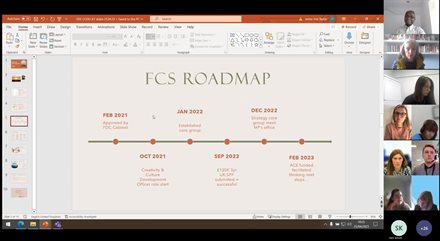 Jaime-Lea explaining the journey undertaken to developing and deliver Broad Horizons
Jaime-Lea explaining the journey undertaken to developing and deliver Broad Horizons
The representatives are drawn from:
- local cultural education partnerships;
- museum and library services;
- national trust properties;
- the local creative and heritage sector;
- Voluntary, Community, and Social Enterprise (VCSE) sector;
- local government; and
- local youth groups.
Investing time to develop Broad Horizons was worth the effort
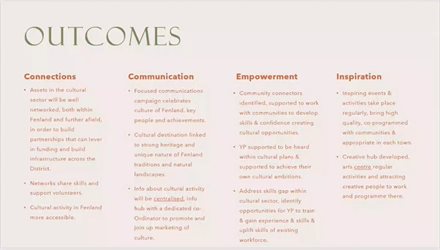 Listed are the outcomes that Broad Horizons set out to achieve
Listed are the outcomes that Broad Horizons set out to achieve
Jaime-Lea emphasised that the process of developing Broad Horizons was a challenging and protracted one that lasted several years before it was written, ratified, and adopted. FDC commissioned an arts and cultural charity based in Leicester called Art Reach to write Broad Horizons. Because this predated Jaime-Lea’s tenure, a steering group had been put in place to oversee the process of development before it came to be renamed as the Cultural Forum. Following adoption, FDC applied for ACE funding to support the creation of a role to facilitate effective delivery of Broad Horizons’ action plan. Jaime-Lea explained that during the development years, a lot of time and effort were invested in
- talking, listening, and understanding people across the District via a range of consultation formats;
- building confidence, relationships, and trust; and
- balancing getting work done on schedule and enabling people participate on their own terms.
Whilst the process of Broad Horizons’ development was funded as noted above, its programmed activities were not — something that presented FDC with a dilemma. It was not clear at that point how the programmed activities would be leveraged to reap benefits for local communities and the local creative and cultural ecosystems going forward.
 Understanding the step-by-step process of developing Broad Horizons and its delivery
Understanding the step-by-step process of developing Broad Horizons and its delivery
One response was to fundraise. However, fundraising was very time-consuming and presented an enormous task in and of itself.
Another response was to engage in advocacy — devising accessible and persuasive ways to communicate the value of the arts and culture.
One set of messages was aimed at local communities and diverse publics, relaying the benefits to be accrued from engagement with the arts and culture.
Another set of messages was designed to influence decision-makers and stakeholders in the wider local economy to envision the broad contribution of culture and creativity to virtually all areas of human activity.
Broad Horizons in action
To achieve these aims within the context presented thus far, the delivery of Broad Horizons set out to:
- raise awareness of what the Cultural Strategy is, what it aims to do, and whom it is designed to serve;
- take stock of progress on a yearly basis — identifying what has been achieved, what is yet to be achieved, and what needs rethinking if the impression arises that some programmed activities appear not to be the right fit;
- adapt to changing circumstances such as unforeseen delays that caused the development process to become protracted owing to a variety of reasons — including the huge disruption caused by the COVID-19 pandemic;
- embrace Cultural Strategy development as a process of continuous learning and ongoing reflection;
- acknowledge that existing geographical inequalities (e.g., poor transport infrastructure and digital connectivity) afflicting the District’s rural areas are bound to pose recurring barriers and challenges to cultural engagement;
- understand that each of the four separate rural towns in the District has its own unique identity and needs, and as such, has to be given its own time and space to engage with the Cultural Strategy on its own terms;
- approaching under-represented communities known to demonstrate low levels of aspiration and engagement with care, respect and sensitivity, ideally with the support of local community champions and/or community connectors;
- demonstrate perceptiveness by demystifying creative and cultural engagement as a means to render such engagement easier to accept and adopt for under-represented communities that may feel that the arts and culture are not for them;
- bring into local communities new faces and voices from outside the arts and cultural sector to help generate interest and valuable ideas to work with; and
- convey as accessibly as possible the rewards to be reaped from engagement with a vibrant creative and cultural offer: (a) facilitating community cohesion, (b) stimulating local pride and identity, (c) improving health and wellbeing, (d) facilitation of job creation, (e) contributing to inclusive economic growth, and (f) enabling skills development.
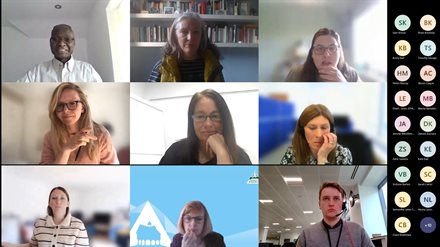 A selection of on-screen delegates in attendance at the Symposium
A selection of on-screen delegates in attendance at the Symposium
In these and other ways, FDC is leveraging Broad Horizons to serve several constituencies at the same time. As Broad Horizons’ programmed activities are continually rolled out, local communities within the District are increasingly benefitting from the offerings of the vibrant creative and cultural activity that is establishing local amenities for which the people of Fenland do not have to leave the District in search of opportunities elsewhere.
As place-based assets (e.g., the Fens) are increasingly harnessed in the context of Broad Horizons’ work, local communities are enjoying their natural landscape in ways that they may never have done before. This, in turn, has potential to attract visitors from outside the District, thereby playing into the aspiration of FDC to make the District a cultural destination. For a region that has experienced negative perceptions for much of its past, this is a very welcome and fitting development.
Top tips for Cultural Strategy development from Fenland
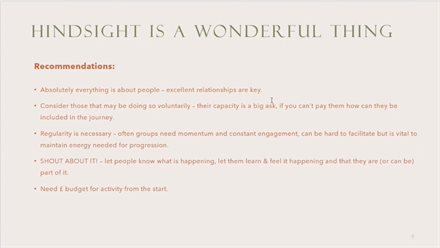 A set of valuable recommendations provided by Jaime-Lea on what to consider when developing a meaningful and impactful Cultural Strategy
A set of valuable recommendations provided by Jaime-Lea on what to consider when developing a meaningful and impactful Cultural Strategy
Jaime-Lea concluded her keynote presentation by offering several useful tips among which the following are noteworthy:
- It is important to build relationships by going out and interacting with as many people and stakeholders as possible and doing so as regularly as may be feasible;
- It takes time, patience, and energy to gather people’s input, make sense of it, and work with it to inform overall direction, mission, and vision but these need to be built into Cultural Strategy development right from the outset;
- It is worth scheduling interaction with people in ways that avert consultation fatigue;
- It is critical to keep stakeholders updated on progress and to ensure they are brought on the journey all the way through;
- It is essential to remember that not everyone who engages and supports the process of Cultural Strategy development and delivery is there in a paid role. People in voluntary and/or unpaid roles should be looked after meaning all efforts should be made to make it possible for them to still engage in an inclusive way;
- It is crucial to understand that partnership working is tested through actually working together.
Part 3: Cultural Strategy development: The approach and experience from Derbyshire
Opting for a ‘Cultural Framework’ as opposed to a ‘Cultural Strategy’
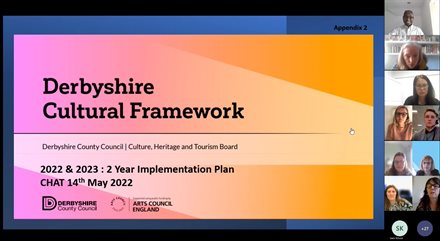 Alison Foote introduces the 'Cultural Framework' developed in Derbyshire
Alison Foote introduces the 'Cultural Framework' developed in Derbyshire
Following Jaime-Lea’s keynote presentation, Alison Foote introduced delegates to the Cultural Strategy development journey that Derbyshire County Council (DCC) went on. It is worth highlighting that DCC purposefully calls it a ‘Cultural Framework’ and not a ‘Cultural Strategy’. To set the scene, Alison provided some helpful context. She noted that DCC works alongside eight district councils and one city council. Each of these has offered arts and cultural provision separately.
Although there was strong partnership working, no strategy was in place to help align provision in a systematic way. This was not helped by ‘disinvestment’ — whereby funding for the arts and culture was substantially reduced countywide.
This was further aggravated by the outbreak of the COVID-19 pandemic. As disruptive as the pandemic was, Alison observed that it also offered DCC a vital opportunity to pause, reflect, plan, and reset. This course of action was informed by a thorough assessment of Derbyshire’s place-based assets, characteristics, strengths, and limitations — including among other things:
- ‘asset-richness’ (e.g., World Heritage sites);
- central location (i.e., right in the middle of the country);
- strong tourism base;
- strong pockets of creative activity — including many creative small and medium-sized enterprises (SMEs);
- high potential to harness interdependencies between culture, heritage and tourism and how they could exploit synergies to support each other to grow; and
- three Arts Council England priority places owing to low engagement in the arts and culture throughout the county. According to Alison, five of the eight districts in Derbyshire are considered to be priority places.
Building resilience, developing skills, and creating employment opportunities across Derbyshire
 Understanding the priorities and vision of Derbyshire's Cultural Framework
Understanding the priorities and vision of Derbyshire's Cultural Framework
In part, these features informed the crafting of a light-touch and agile Five-Year Framework that was designed to adapt to change. The triad of culture, heritage and tourism was placed at the heart of the Framework.
The Framework put a strong emphasis on building resilience, developing skills, and creating employment opportunities across the county. DCC commissioned an arts-led cultural production agency based in Manchester called Curated Place to develop and deliver the Framework.
However, the Framework is not a DCC document per se but is overseen by a strategic partnership board called the ‘Culture, Heritage and Tourism’ (CHAT) Board which works across the cultural, heritage, and tourism sectors.
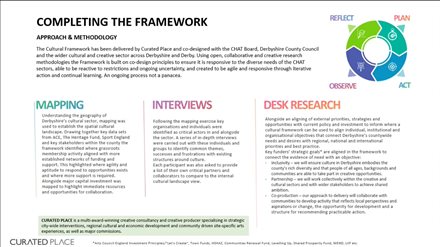
Captured in this image are the approach and methodology employed to gather information and evidence to inform Cultural Framework development and delivery
Alongside strong political representation at county and city council levels, other organisational members that sit on the CHAT Board include among others:
Deploying a spatial mapping exercise to identify assets, strengths, limitations, and foci for development and investment
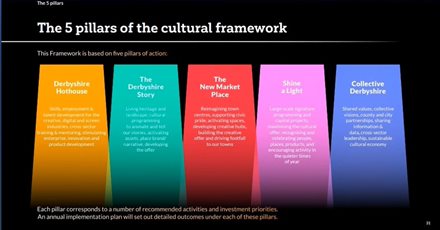 Outlined in this image are the five 'pillars' underpinning Derbyshire's Cultural Framework
Outlined in this image are the five 'pillars' underpinning Derbyshire's Cultural Framework
During the development process of the Cultural Framework, Alison explained that the large size of the county necessitated undertaking a spatial mapping exercise to identify appropriate opportunities for development and investment in culture, heritage and tourism and to keep an eye on potential, future funding schemes to support that development and investment. For instance, Alison spoke of how the spatial mapping exercise surfaced key perceived strengths such as identifying:
- where people live and work from;
- where investment is happening; and
- which areas are characterised by distinctive place-based assets — including mapping any opportunities and strengths associated with those assets.
Cases in point include some of the assets and characteristics mentioned earlier: (1) The National Forest, and (2) Derbyshire’s central location in the middle of the country. The insights gained here were compared with other similar local authorities across both the East Midlands and England as a whole. The spatial mapping exercise was complemented by economic analyses of key performing indicators across city, district, and county levels.
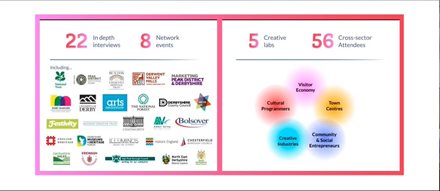 Further material capturing key details of the approach and methodology employed in the development of Derbyshire's Cultural Framework
Further material capturing key details of the approach and methodology employed in the development of Derbyshire's Cultural Framework
With the support of consultancy services, the analyses — which resulted from extensive desk research and wide-ranging input from numerous in-depth interviews with stakeholders — informed the establishment of five creative labs with different foci:
- visitor economy;
- town centres;
- creative industries;
- cultural programmers; and
- community and social entrepreneurs.
 A general overview of the five pillars underpinning Derbyshire's Cultural Framework
A general overview of the five pillars underpinning Derbyshire's Cultural Framework
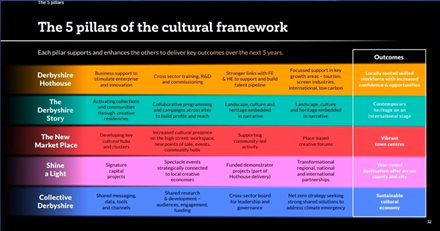 A systematic break down of the five pillars at the heart of the Cultural Framework developed in Derbyshire
A systematic break down of the five pillars at the heart of the Cultural Framework developed in Derbyshire
In turn, the input from the creative labs informed the generation of five key pillars:
- Derbyshire Hothouse which focuses on (a) skills development, (b) job creation and employment, particularly in the experience economy, international screen industries, and low carbon sector, and (c) talent development, including talent attraction as well as labour retention and diversification via higher education (HE);
- Derbyshire Story which celebrates the county’s cultural heritage, stories, landscape and people;
- New Marketplace which is centred on (a) reimagining town centres and supporting civic pride using the arts and creativity for enlivenment, and (b) supporting self-sufficiency in areas such as local and regional food production across the county’s twenty-seven market towns, something that enabled people to shop locally during the pandemic;
- Shine a Light which is a large-scale projection that brings history to life through light and sound, and in doing so, adds a distinctive signature project to the creative and cultural offerings enjoyed by local communities and out-of-county visitors; and
- Collective Derbyshire which leads and coordinates countywide efforts to sustain multi-sectoral collaboration.
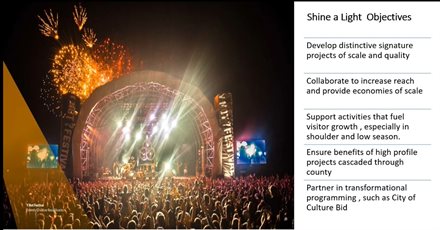 Image capturing a Shine a Light large-scale projection event
Image capturing a Shine a Light large-scale projection event
Alison shared some further crucial context that surrounded the process of developing the Framework. She noted that the Framework was commissioned shortly before local elections meaning there was some uncertainty around how the development process would unfold — and whether the Framework would be adopted if new County leadership assumed power.
The incumbent leadership did stay in power which provided a welcome level of stability — according to Alison. More importantly, that leadership committed one million pounds via a funding programme to support culture, heritage and tourism during the post-pandemic recovery phase and beyond.
One area that has stood out is the support allocated to develop Derbyshire into a location for filming, with a particular emphasis on supporting the production of films within the county itself.
Part 4: Cultural Strategy development: The approach and experience from Kent
Utilising culture and creativity to deliver outcomes across multiple sectors
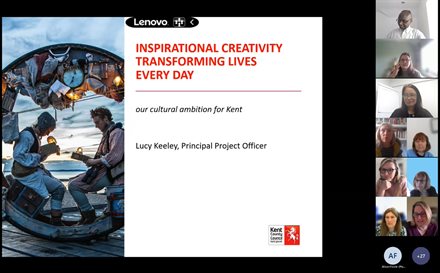 Lucy Keely discusses the process of developing Kent County Council's Cultural Strategy
Lucy Keely discusses the process of developing Kent County Council's Cultural Strategy
Next up was Lucy Keeley’s keynote presentation which relayed the journey that Kenty County Council’s (KCC) Cultural Strategy underwent. Lucy narrated that the first iteration of KCC’s Cultural Strategy run from 2010 to 2015.
Towards the end of that period, the county was experiencing fast-changing social, economic, and political transformations that shaped conversations and discussions about what form a ‘refresh’ could take.
This coincided with an emerging confidence around the growing influence and position of the cultural and creative industries (CCIs) in the county, their contribution to the regional economy, and to the general wellbeing and quality of life of the people of Kent.
Throughout its five-year lifecycle, KCC’s first Cultural Strategy articulated a new vision for the CCIs which committed to making best use of public investment by (1) encouraging business growth, (2) supporting more financial resilience, (3) stressing the importance of culture in delivering outcomes across other agendas, and (4) meeting KCC's strategic objectives.
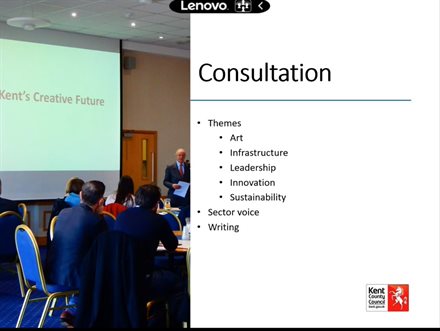 Image capturing one of numerous consultation events with wide-ranging stakeholders during the processes of developing and 'refreshing' Kent County Council's Cultural Strategy
Image capturing one of numerous consultation events with wide-ranging stakeholders during the processes of developing and 'refreshing' Kent County Council's Cultural Strategy
KCC’s approach to the development of its first Cultural Strategy involved holding conversations led by industry professionals. Those conversations provided opportunities for:
- reflection on previous successes;
- better understanding gaps in delivery and identifying measures to grow the regional economy; and
- crafting a revised action plan to support Kent to achieve a reputation for excellent cultural production and activity.
These features laid the foundation on which the renewal of KCC’s Cultural Strategy was built. Drawing on rich past learning, the renewal process was collaborative — overseen by the Council and a Cultural Transformations Board (CTB).
The CTB — like the Cultural Forum (Fenland) and the CHAT Board (Derbyshire) — served in the capacity of a steering group that provided (1) strategic direction, (2) varied expertise and perspectives, and (3) the ‘connective tissue’ that binds multi-sectoral stakeholders together around a shared mission and vision.
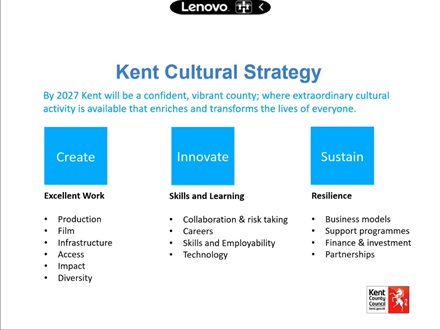 Presented are the priorities outlined by Kent County Council's Cultural Strategy
Presented are the priorities outlined by Kent County Council's Cultural Strategy
As was the case in the development process in the past, the renewal phase was characterised by a mode of stakeholder engagement and consultation that spanned a twelve-month period involving:
- one-to-one interviews;
- two stakeholder conference-style events; and
- internal departmental consultation.
Lucy explained that this approach was purposefully adopted to enable stakeholders to get involved in inclusive ways and to take account of their different engagement styles.
Additionally, KCC supported multi-sectoral partners to host sessions on their own terms and without public sector bureaucracy and encouraged them to share feedback.
Several key, emerging themes were extracted from the stakeholder material generated by the first conference-style event. These include:
- art;
- work products;
- events and activity;
- infrastructure: where the work is made and who makes it;
- leadership: importance of committed and inspirational cultural leaders;
- innovation: importance of developing creative skills and testing new ideas; and
- sustainability: updated business models and different approaches to financing the creative industries.
Crafting high-level outcomes: Create, innovate and sustain
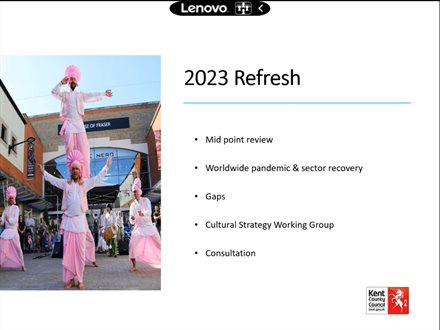 An account of the renewal process of Kent County Council's first Cultural Strategy
An account of the renewal process of Kent County Council's first Cultural Strategy
Following theme generation and to ensure a good breadth of representative views across multiple sectors, the second conference-style event was held — with the goal being to ‘play back’ material to all the stakeholders. Feedback received was used to refine the emergent themes.
At this stage, a Cultural Strategy Working Group comprising KCC officers and CTB members was established. The Group (1) agreed a vision statement, (2) formulated several high-level outcomes, and (3) outlined the Cultural Strategy framework. This culminated in the writing of the Cultural Strategy.
However, Lucy intimated, this proved challenging for two main reasons.
First, the first draft turned out to be too bureaucratic for creative practitioners meaning it had to be substantially revised.
Second, the revised draft went the opposite way — applying lyrical language that masked the content and obscured what was supposed to be conveyed.
Both scenarios were problematic because the Cultural Strategy needed to fulfil a two-fold objective: to function as both (1) a political tool, and (2) a script for creative advocacy. Lucy intimated further that following many Working Group meetings and much back and forth to try and please everybody, a decision was made to take control. Two selected people sat down and distilled contents — producing a version that sat between the political and creative advocacy objectives and/or functions.
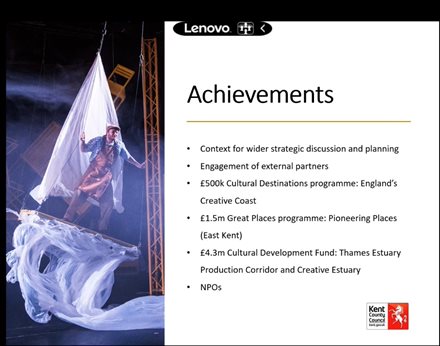 A further account of the renewal process of Kent County Council's first Cultural Strategy — offering a break down of stakeholder engagement and funded programmes and/or projects
A further account of the renewal process of Kent County Council's first Cultural Strategy — offering a break down of stakeholder engagement and funded programmes and/or projects
According to Lucy, the version presented brief and clear messaging which seemed to resonate with all stakeholders. More importantly, this version of the Cultural Strategy fit on a single page.
It sets out a ten-year vision to position culture as a positive influence on all people living, working, studying in, and visiting Kent. For clarity and precision, it has three actions with several high-level outcomes:
- create which involves (a) showcasing creative work, (b) supporting people to make work and places for them to show it, (c) making sure people are able to see and experience work in a variety of settings, (d) ensuring the work is of sufficient quality to have a lasting effect and deliver a range of positive outcomes, and (e) ensuring the work made is representative of Kent communities;
- innovate which foregrounds (a) provision of skills and learning to encourage collaboration and risk-taking, (b) provision of accessible and affordable workspace to enable this to happen and to facilitate business growth, (c) provision of advice on creative careers, (d) establishment of appropriate learning pathways to enable people to develop the right skills and to understand the world of work, and (e) adoption of the opportunities offered by technology; and
- sustain which focuses on (a) exploring (new) business models and providing tailored support to enable them to grow, (b) addressing access to finance and seeking sources of investment, (c) brokering collaborative working, (d) forming partnerships to create critical mass in an industry dominated by freelance individuals and small businesses, (e) creating wider cross-sector links with public health, education, housing developers and others where synergies exist for effective collaboration.
Focused development and targeted investment in the creative, cultural, and visitor economies
The second iteration of KCC’s Cultural Strategy was published in 2017. One action plan at the time was to review the Strategy around 2020/2021 but then COVID-19 struck. Considering the huge disruption the pandemic caused, and the significant changes it engendered (which hit the creative and cultural sector much harder than most other realms), the Cultural Strategy Working Group seized the opportunity to reorient review.
 A selection of on-screen delegates in attendance at the Symposium
A selection of on-screen delegates in attendance at the Symposium
The renewed focus identified gaps in the second iteration of the Strategy. Requisite data collection and evidence-gathering was undertaken to support efforts to fill the gaps. The new focus also incorporated a greater emphasis on equality, diversity and inclusion (EDI) while foregrounding collective environmental responsibilities.
Here, Lucy explained, the review process utilised a comprehensive online survey and a series of roundtables to refine priorities comprising:
- the next generation;
- workforce; and
- place-making.
CTB has since been renamed Creative Kent. Lucy provided some very interesting examples illustrating how KCC’s ‘refreshed’ Cultural Strategy has leveraged partnership working across multiple sectors to guide focused development and targeted investment in the creative, cultural, and visitor economies across the county and region.
For instance, England's Creative Coast — an ambitious arts and tourism project led by Turner Contemporary and Visit Kent worth £500,000 of investment — is increasing tourists to the creative coast in the Southeast by creating an innovative and immersive new visitor experience driven by the region's exceptional art and culture. Another project called the Thames Estuary Production Corridor is a £5.3 million investment designed to encourage development of creative industries extending from London out along the estuary to the North Kent coast, and South Essex. The ambition is to make the corridor a world-class hub for creative and cultural production among other things.
Top tips for Cultural Strategy development from Kent
Lucy concluded her keynote presentation with some top tips which are categorised under the following keywords:
Time
- It is important to understand from the outset that Cultural Strategy development can be a lengthy process, and as such, must be given the time it needs — if it is to be successful;
- It is vital to give stakeholders the feeling that they have had the opportunity to input meaningfully and to review of gathered material as it emerges;
- It is critical not to jump too far ahead without communicating fully to stakeholders as people may think they have missed a step in the process or that things are being hidden from them.
Challenges
- It is helpful to be prepared to be challenged. Likewise, it is critical to be prepared to challenge;
- It is crucial to show people that their input is valued, and to convey to people that they are genuinely being listened to;
- It helps to develop confidence in the starting point of the Cultural Strategy and the context within which it has been developed, written, published, and adopted.
Consensus and diversity
- It helps to acknowledge that there may not (always) be consensus but to find a way through — nonetheless;
- It is useful to enlist advocates respected sector wide as cultural champions to articulate the value of the priorities and vision of the Cultural Strategy in ways that help achieve shared ambitions;
- It is vitally important to enable a diverse range of people and opinions to be reflected both through the consultation and within the Strategy itself.
Ambition
- It is important to encourage and support ambition;
- It pays dividends to be bold and ambitious and encourage people to think outside the box;
- It helps to draw on the support of creative leaders to inspire quality.
Leadership
- It is crucial to demonstrate leadership by listening and including people in the development process;
- It is beneficial to be seen to listen and be inclusive, transparent, and accountable in interactions with people;
- It helps to seek consensus whilst taking the lead;
- It is vitally important to develop confidence and the ability to describe and defend the content and structure of the Cultural Strategy as being the right thing.
Part 5: The Q&A session and a selection of concluding remarks and key takeaways
The value of baseline data in evaluation and mechanisms for attracting major investors in places
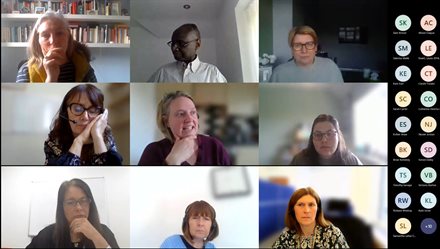 Q&A session in progress
Q&A session in progress
In the Q&A session that followed, delegates posed questions to our keynote speakers. For instance, one question asked about the rationale that informed Derbyshire County Council’s (DCC) choice to use ‘Cultural Framework’ instead of ‘Cultural Strategy’.
What this highlighted is the importance of paying attention to the use of language and terminology in Cultural Strategy development — including what that use is intended to convey or relay.
Another question asked about productive ways to raise awareness amongst residents, citizens, and stakeholders regarding the importance of culture. Yet another question asked about effective ways to measure and/or evaluate the impact of a Cultural Strategy.
In response to the last question, Alison noted from a DCC perspective that making the generation of baseline data a priority has been found to support meaningful evaluation. Where in the past baseline data across the sectors of culture, heritage, and tourism have not talked to each other, there is currently a concerted effort to ensure those data speak to each other to enhance the process of insight-generation and, ultimately, effective evaluation. That said, Alison added, getting hold of the ‘right’ data has proved challenging.
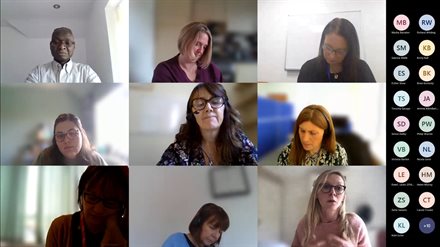 Q&A session in progress
Q&A session in progress
At Kent County Council, Lucy explained that it was paramount to clarify from the outset what data were needed to ‘refresh’, and what data needed collecting as part of the delivery of the Cultural Strategy.
A further question asked about the mechanisms for attracting major investors to drive massive regeneration projects in places. From KCC’s perspective, Lucy responded by saying that it was about (1) looking for opportunities, (2) understanding who is already present in the county that can support with achieving those opportunities, (3) bringing partners together to collectively make things happen on a scale of that size, and (4) bringing key and influential players into the mix.
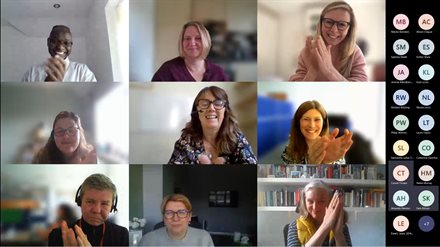 On-screen delegates applauding our keynote speakers and themselves for what was a very informative and productive event
On-screen delegates applauding our keynote speakers and themselves for what was a very informative and productive event
Some very interesting discussion revolved around how Margate — a seaside town located in the county of Kent — underwent considerable transformation as a result of a major regeneration venture that saw the establishment of the Turner Contemporary mentioned earlier for which the town is now nationally and internationally renowned.
In April 2023, a television series set in the town called Dreamland was broadcast — adding to the visibility and appeal of Kent as a unique place. According to Lucy, this has had a snowballing effect. The decline of the cultural and tourism sectors during the mid-2000s appears to have been completely reversed.
Since its inception, Turner Contemporary has invested a huge amount of work in engaging with surrounding local communities and animating the entire region in cultural, economic and social ways.
Selected concluding remarks and key takeaways
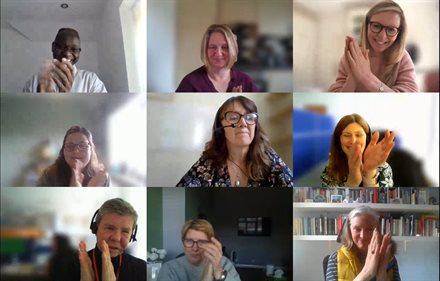 On-screen delegates applauding our keynote speakers and themselves for what was a very informative and productive event
On-screen delegates applauding our keynote speakers and themselves for what was a very informative and productive event
Some concluding remarks and seelcted takeaways from Sophie Frost and Cat Rogers included:
- being clear about who a Cultural Strategy is for;
- the importance of navigating sometimes conflicting and different agendas to craft shared priorities;
- understanding that a Cultural Strategy is never a finished product but one subject to revision at regular intervals to accommodate evolving circumstances;
- being mindful of the language and terminology in use — and what that may or may not convey;
- harnessing the power of collaboration; and
- internalising the fact that Cultural Strategy development and policy take time and that not all barriers and challenges can be tackled and fixed at once.
The Symposium ended with a thunderous round of applause for our keynote speakers but also for our delegates who clearly enjoyed the event as much as we did!